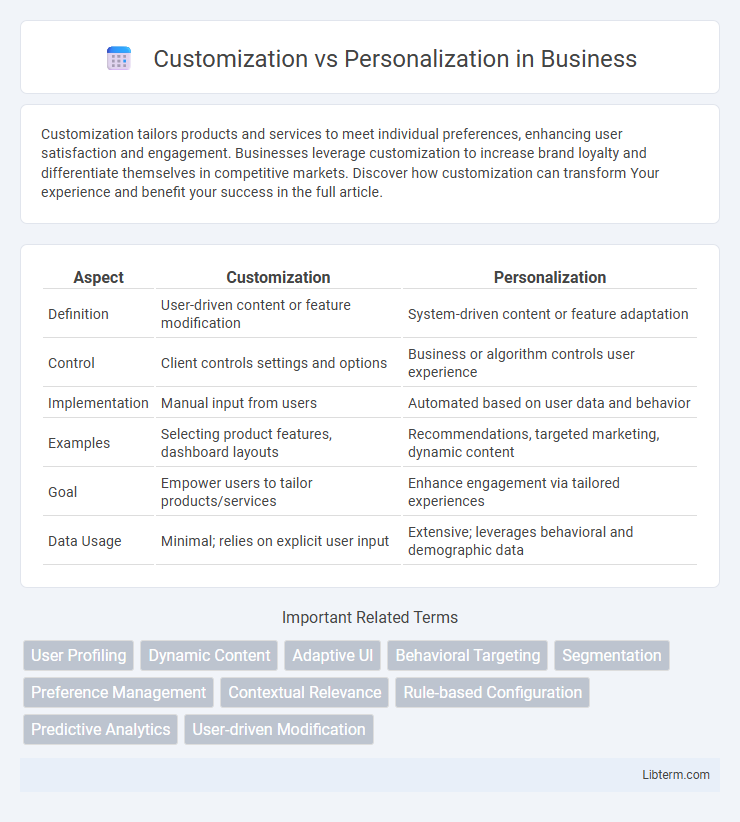Customization tailors products and services to meet individual preferences, enhancing user satisfaction and engagement. Businesses leverage customization to increase brand loyalty and differentiate themselves in competitive markets. Discover how customization can transform Your experience and benefit your success in the full article.
Table of Comparison
| Aspect | Customization | Personalization |
|---|---|---|
| Definition | User-driven content or feature modification | System-driven content or feature adaptation |
| Control | Client controls settings and options | Business or algorithm controls user experience |
| Implementation | Manual input from users | Automated based on user data and behavior |
| Examples | Selecting product features, dashboard layouts | Recommendations, targeted marketing, dynamic content |
| Goal | Empower users to tailor products/services | Enhance engagement via tailored experiences |
| Data Usage | Minimal; relies on explicit user input | Extensive; leverages behavioral and demographic data |
Introduction to Customization and Personalization
Customization allows users to actively modify products or services according to their preferences, enhancing engagement by providing control over specific features. Personalization uses data-driven algorithms to automatically tailor content, recommendations, or experiences based on individual user behavior and preferences. Both approaches aim to increase user satisfaction and relevance, but customization relies on explicit user input while personalization depends on implicit data analysis.
Defining Customization: User-Controlled Experiences
Customization allows users to actively modify and tailor digital products or services according to their preferences, creating a user-controlled experience. This process empowers individuals to select features, adjust settings, or design interfaces that suit their unique needs and priorities. By prioritizing user control, customization enhances engagement and satisfaction through personalized interaction choices.
What is Personalization? Data-Driven Adaptation
Personalization is a data-driven adaptation approach that tailors content, products, or experiences to individual user preferences and behaviors by leveraging analytics and machine learning algorithms. This process uses real-time data such as browsing history, purchase patterns, and user interactions to create uniquely relevant offerings. By analyzing extensive user data, personalization enhances engagement, satisfaction, and conversion rates through dynamically customized user experiences.
Key Differences Between Customization and Personalization
Customization allows users to actively modify products or interfaces according to their preferences, offering control over features, settings, and appearance. Personalization uses data-driven algorithms to automatically tailor content, recommendations, or experiences based on user behavior, demographics, and preferences. The key difference lies in user involvement: customization requires direct user input, whereas personalization is system-initiated to enhance relevance without user intervention.
Benefits of Customization for Businesses
Customization empowers businesses to tailor products and services directly to customer specifications, enhancing satisfaction and loyalty through unique user experiences. It enables companies to differentiate their offerings in competitive markets, driving higher customer engagement and repeat purchases. By leveraging customer data and preferences, customization reduces returns and increases profitability while fostering stronger brand affinity.
Advantages of Personalization in User Engagement
Personalization enhances user engagement by delivering tailored content and experiences that meet individual preferences and behaviors, increasing satisfaction and loyalty. It enables dynamic adjustments based on real-time data, fostering deeper emotional connections and higher conversion rates. Personalized interactions reduce friction and create relevant touchpoints, boosting retention and long-term user value.
Challenges and Limitations of Both Approaches
Customization faces challenges such as requiring users to have enough knowledge and motivation to adjust settings effectively, often resulting in a limited user experience if preferences are inaccurately set. Personalization relies heavily on data collection and sophisticated algorithms, raising privacy concerns and the risk of reinforcing filter bubbles by limiting content diversity. Both approaches struggle with scalability and adaptability in dynamic environments where user needs and preferences rapidly evolve.
Examples of Customization and Personalization in Practice
Customization allows users to directly modify settings such as choosing dashboard layouts in data analytics platforms or selecting color schemes in graphic design software. Personalization leverages algorithms to tailor content automatically, like Netflix suggesting shows based on viewing history or Spotify creating playlists from listening patterns. Both approaches enhance user engagement by either empowering choices or by delivering contextspecific experiences.
Choosing the Right Strategy for Your Business
Choosing the right strategy between customization and personalization depends on your business goals and customer preferences. Customization allows customers to actively modify products or services to meet their specific needs, enhancing engagement and satisfaction. Personalization leverages data and AI to deliver tailored experiences automatically, increasing relevance and driving faster decision-making.
Future Trends: The Evolving Landscape of UX
Future trends in UX highlight a shift from basic customization, where users manually adjust settings, to advanced personalization powered by AI and machine learning algorithms that adapt interfaces based on individual behavior and preferences. Emerging technologies like predictive analytics and real-time data integration enable hyper-personalized user experiences, enhancing engagement and satisfaction across digital platforms. The evolving landscape emphasizes seamless, context-aware interactions that anticipate user needs, transforming UX design into a dynamic, user-centric ecosystem.
Customization Infographic

 libterm.com
libterm.com